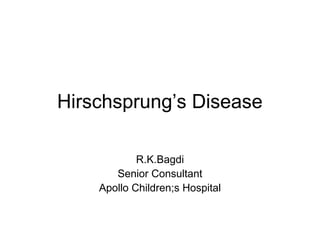Hirschsprungs disease
- 1. Hirschsprungâs Disease R.K.Bagdi Senior Consultant Apollo Children;s Hospital
- 2. Patient S.C. âĒ Newborn male âĒ Full-term, uncomplicated vaginal delivery âĒ Normal birth weight: 3115 g âĒ Apgars 91, 95 âĒ Mother: 36 yo, G1P0, healthy
- 3. Patient S.C. âĒ Started breast feeding DOL 1 âĒ DOL 2-3 noted to have increasing abdominal distention âĒ No meconium passed in first 24 hrs of life âĒ 1 episode Non-bilious emesis
- 4. Patient S.C.
- 5. Patient S.C. âĒ Pediatric Surgical Consult âĒ Rectal Exam â Empty rectal ampulla â Tight anal sphincter â Large amount of stool and air upon withdrawal of finger
- 6. Patient S.C.
- 7. Patient S.C. âĒ Rectal mucosal biopsy â No ganglia identified
- 8. Patient S.C.
- 9. Patient S.C. âĒ Pt taken to OR for end colostomy and Hartmannâs pouch âĒ Dilated descending and sigmoid colon âĒ Prominent colonic blood vessels âĒ Site of colostomy, frozen section of colonic muscularis propria revealed ganglion cells
- 10. Patient S.C.
- 11. Patient S.C. âĒ Postoperative course uneventful âĒ Stool from colostomy POD 1 âĒ Tolerated breast feeding âĒ Discharged POD 6 âĒ 2nd stage pull through procedure planned in several weeks
- 12. Hirschsprungâs Disease R.K.Bagdi Apollo Childrenâs Hospital
- 13. Hirschsprungâs Disease âĒ Neurogenic form of intestinal obstruction âĒ Absence of ganglion cells in the myenteric and submucosal plexus âĒ Failure in relaxation of the internal anal sphincter and affected bowel âĒ Upstream bowel becomes dilated secondary to functional obstruction
- 14. History âĒ 1691 Ruysch latin texts âĒ 1886 Harald Hirschsprung â autopsy âĒ 1901 Tittel â histologic findings âĒ 1949 Swenson â pathophysiology and definitive operative treatment
- 15. Epidemiology âĒ Prevalence: 1/5000 births âĒ 3-5% of pts have Downâs syndrome âĒ Definite family history âĒ 80% affected are boys âĒ Total colonic aganglionosis, 35% girls âĒ >95% cases are full term babies
- 16. Pathogenesis
- 17. Pathogenesis âĒ Failure of neural crest cells to migrate caudally âĒ Aganglionosis begins at anorectal line âĒ 80% involve only rectosigmoid area âĒ 10% extend proximal to splenic flexure âĒ 10% involves the entire colon and part of small bowel âĒ Rarely involves entire gastrointestinal tract
- 18. Pathogenesisâgenetics âĒ 10th chromosome âĒ RET-protooncogene âĒ Endothelin B gene
- 19. Presentation
- 20. Presentation âĒ Severe abdominal distention âĒ 95% - failure to pass meconium in first 24 hours life âĒ Bilious vomiting âĒ Older children - constipation, failure to thrive âĒ 10-15% - severe diarrhea alternating w/ constipationâenterocolitis of Hirschsprungâs disease
- 21. Diagnosis âĒ Abdominal plain X-rays âĒ Barium Enema âĒ Rectal Biopsies âĒ Anal manometry
- 22. Abdominal X-ray
- 23. Barium Enema
- 24. Barium Enema âĒ Less sensitive for detecting short lesions, total colon aganglionosis, and disease of the newborn âĒ Many newborns do NOT show definitive transition zone âĒ Delayed evacuation of contrast
- 25. Rectal biopsy âĒ Submucosal suction biopsy â Meissnerâs submucosal plexus âĒ Full thickness rectal biopsy â Auerbachâs myenteric plexus âĒ Acetylcholinesterase staining â increased staining of neurofibrils
- 26. Anorectal manometry âĒ Absent rectoanal inhibitory reflex âĒ Lack of internal anal sphincter relaxation in response to rectal stretch
- 27. Surgical Options âĒ Swenson Procedure (1948) âĒ Duhamel Procedure (1960) âĒ Soave Procedure (1963)
- 28. Swenson Procedure âĒ Sharp extrarectal dissection down to 2 cm above the anal canal âĒ Aganglionic colonic segment resected âĒ End-to-end anastamosis of normal proximal colon to anal canal âĒ Completely removes defective aganglionic colon
- 30. Duhamel Procedure âĒ Posterior portion of defective colon segment resected âĒ Side to side anastamosis to left over portion of rectum âĒ Constipation a major problem d/t remaining aganglionic tissue âĒ Simpler operation, less dissection
- 32. Soave Procedure âĒ Circumferential cut through muscular coat of colon at peritoneal reflection âĒ Mucosa separated from the muscular coat down to the anal canal âĒ Proximal normal colon is pulled through retained muscular sleeve âĒ Telescoping anastamosis of normal colon to anal canal
- 33. Soave Procedure
- 34. Soave Procedure âĒ Advantage: rectal intramural dissection ensures no damage to pelvic neural structures âĒ Higher rate enterocolitis, diarrhea âĒ Problems w/ cuff abscesses, often requires repeated dilations
- 35. Overall Mortality âĒ Swenson procedure: 1-5% âĒ Duhamel procedure: 6% âĒ Soave procedure: 4-5%
- 36. Operative complications âĒ Leak at anastamosis: 5-7% âĒ Postop Enterocolitis: 19-27% âĒ Constipation âĒ Stricture Formation âĒ Incontinence
- 37. One vs Two Stage procedure âĒ Historically, two stage procedure performed: preliminary colostomy, then completion pull through âĒ Delicate muscular sphincters of newborn may be injured âĒ 1980s, 1 stage procedures became more popular
- 38. One vs Two Stage procedure â Early complications: No difference in incidence of anastomotic leak, pelvic infection, prolonged ileus, wound infection, wound dehiscence â Late complications: No difference in incidence of anastomonic stricture, late obstruction, constipation, incontinence, urgency â Postoperative enterocolitis higher in 1 stage (42% vs 22%)
- 39. Laparoscopic techniques âĒ Small studies of laparoscopic pull through procedures âĒ Excised aganglionic tissues removed through anal canal, no abdominal incision âĒ Better results in terms of pain, return of bowel function, hospital stay âĒ Similar incidence of leaks, pelvic abscesses, enterocolitis, postop bowel function






































